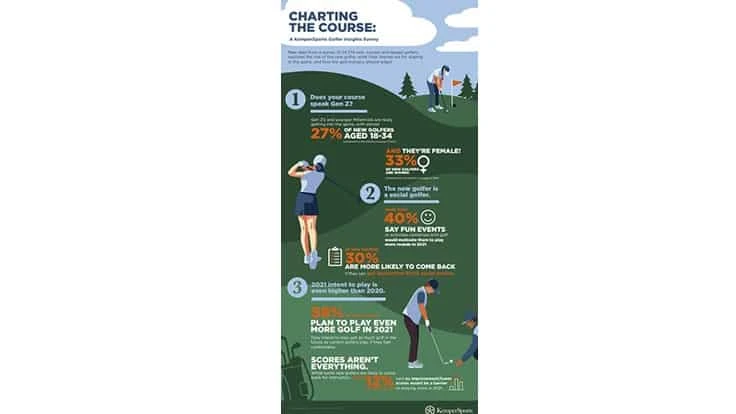
Courtesy of KemperSports
- The new golfer is a social golfer – younger and female. Gen Z and younger millennials are really getting into the game, with almost 27 percent of new golfers representing the 18-34 age group. In addition, women entered the game in a big way, representing almost 33 percent of new golfers surveyed, compared to the industry average of 24 percent.
- Once they played, they couldn’t stay away. Almost 60 percent of respondents played more than 25 rounds last year, including one-third of new golfers. And, about 30 percent of all respondents played between eight and 24 rounds. This means that more than half of surveyed golfers played more rounds than the industry average.
- 2021 intent to play is even higher than 2020. The majority of new golfers (58 percent) came to the game because of the pandemic. But, they plan to play even more golf in 2021 and intend to play just as much golf in the future as current golfers play, if they feel comfortable and confident. For the new golfer, 30 percent of those surveyed are more likely to come back if they can get instruction and social events.
- “Fun” will keep new players coming back for more. The fun factor is important to new golfers, with more than 40 percent saying fun events or activities combined with golf would motivate them to play more rounds in 2021. And lastly, scores aren’t everything. Only about 12 percent of new golfers said no improvement/lower scores would be a barrier to playing more in 2021.
This year, KemperSports launched its new All Welcome initiative designed to attract, welcome and retain new and diverse golfers at our properties. The playbook provides KemperSports’ clients and locations with research insights, property assessments, communication toolkits and event programming that invites new players to enjoy the game their way and helps them feel more welcome once they arrive. As part of the program, participating KemperSports properties offer complimentary 15-minute lessons, virtual/social instructional content and clinics as part of its player development initiatives.
In conjunction with All Welcome and the need to grow and diversify the game beyond the pandemic surge, the company also signed on as the first golf course management company to help launch the golf industry’s new Make Golf Your Thing initiative alongside the PGA TOUR, PGA of America, Callaway, Titleist and more. Through this movement, KemperSports will be offering a series of social and instructional events to create the welcoming atmosphere these new golfer’s desire, along with a supporting marketing campaign to attract new and diverse audiences to the game.
Latest from Golf Course Industry
- From the publisher’s pen: Conscientious of a bigger role
- Bernhard and Company partners with Laguna Golf Phuket
- Terre Blanche showcases environmental stewardship
- VIDEO: Introducing our December issue
- Bernhard and Company introduces Soil Scout
- Nu-Pipe donates to GCSAA Foundation’s Centennial Campaign
- GCSAA enhances golf course BMP tool
- Melrose leadership programs sending 18 to 2026 GCSAA Conference and Trade Show





